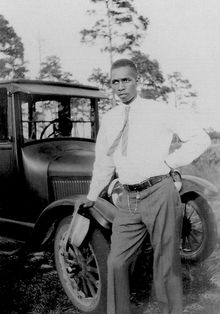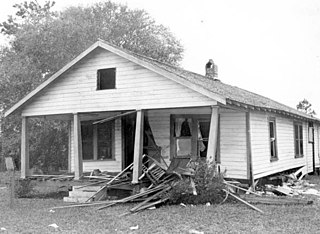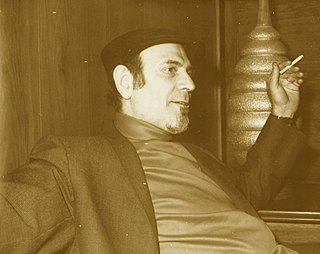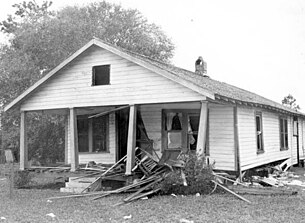
Mims is a census-designated place (CDP) holding the single zip code 32754 located within Brevard County, Florida. The population was 7,058 at the 2010 United States Census.

The 16th Street Baptist Church bombing was a terrorist bombing of the 16th Street Baptist Church in Birmingham, Alabama on September 15, 1963. The bombing was committed by a white supremacist terrorist group. Four members of a local Ku Klux Klan (KKK) chapter planted 19 sticks of dynamite attached to a timing device beneath the steps located on the east side of the church.

Viola Fauver Liuzzo was an American civil rights activist. In March 1965, Liuzzo heeded the call of Martin Luther King Jr. and traveled from Detroit, Michigan, to Selma, Alabama, in the wake of the Bloody Sunday attempt at marching across the Edmund Pettus Bridge. Liuzzo participated in the successful Selma to Montgomery marches and helped with coordination and logistics. At the age of 39, while driving back from a trip shuttling fellow activists to the Montgomery airport, she was fatally hit by shots fired from a pursuing car containing Ku Klux Klan members Collie Leroy Wilkins Jr., William Orville Eaton, Eugene Thomas, and Gary Thomas Rowe, the last of whom was actually an undercover informant working for the Federal Bureau of Investigation (FBI).

The murders of Chaney, Goodman, and Schwerner, also known as the Freedom Summer murders, the Mississippi civil rights workers' murders, or the Mississippi Burning murders, were the abductions and murders of three activists in Philadelphia, Mississippi, in June 1964, during the Civil Rights Movement. The victims were James Chaney from Meridian, Mississippi, and Andrew Goodman and Michael Schwerner from New York City. All three were associated with the Council of Federated Organizations (COFO) and its member organization, the Congress of Racial Equality (CORE). They had been working with the Freedom Summer campaign by attempting to register African Americans in Mississippi to vote. Since 1890 and through the turn of the century, Southern states had systematically disenfranchised most black voters by discrimination in voter registration and voting.

Harry Tyson Moore was an African-American educator, a pioneer leader of the civil rights movement, founder of the first branch of the National Association for the Advancement of Colored People (NAACP) in Brevard County, Florida, and president of the state chapter of the NAACP.

Willis Virgil McCall was sheriff of Lake County, Florida. He was elected for seven consecutive terms from 1944 to 1972. He gained national attention in the Groveland Case in 1949. In 1951, he shot two defendants in the case while he was transporting them to a new trial and killed one on the spot. Claiming self-defense, he was not indicted for this action. He also enforced anti-miscegenation laws and was a segregationist.
The Groveland Four were four African American men, Ernest Thomas, Charles Greenlee, Samuel Shepherd, and Walter Irvin. In July 1949, the four were accused of raping a white woman and severely beating her husband in Lake County, Florida. The oldest, Thomas, tried to elude capture and was killed that month. The others were put on trial. Shepard and Irvin received death sentences, and Greenlee was sentenced to life in prison. The events of the case led to serious questions about the arrests, allegedly coerced confessions and mistreatment, and the unusual sentencing following their convictions. Their incarceration was exacerbated by their systemic and unlawful treatment—including the death of Shepherd, and the near-fatal shooting of Irvin. Greenlee was paroled in 1962 and Irvin in 1968. All four were posthumously exonerated by the state of Florida in 2021.

The La Grange Church and Cemetery is a historic Carpenter Gothic church and cemetery in Titusville, Florida, United States. It is located at 1575 Old Dixie Highway. On December 7, 1995, it was added to the U.S. National Register of Historic Places.

James Ford Seale was a Ku Klux Klan member charged by the U.S. Justice Department on January 24, 2007, and subsequently convicted on June 14, 2007, for the May 1964 kidnapping and murder of Henry Hezekiah Dee and Charles Eddie Moore, two African-American young men in Meadville, Mississippi. At the time of his arrest, Seale worked at a lumber plant in Roxie, Mississippi. He also worked as a crop duster and was a police officer in Louisiana briefly in the 1970s. He was a member of the militant Klan organization known as the Silver Dollar Group, whose members were identified with a silver dollar; occasionally minted the year of the member's birth.
Mississippi Cold Case is a 2007 feature documentary produced by David Ridgen of the Canadian Broadcasting Corporation about the Ku Klux Klan murders of two 19-year-old black men, Henry Hezekiah Dee and Charles Eddie Moore, in Southwest Mississippi in May 1964 during the Civil Rights Movement and Freedom Summer. It also explores the 21st-century quest for justice by the brother of Moore. The documentary won numerous awards as a documentary and for its investigative journalism.

Vernon Ferdinand Dahmer Sr. was an American civil rights movement leader and president of the Forrest County chapter of the NAACP in Hattiesburg, Mississippi. He was murdered by the White Knights of the Ku Klux Klan for his work on recruiting Black Americans to vote.
Brevard County, Florida, provides a number of unique services to help the aged, juveniles, the physically and mentally handicapped, and minorities.

Harriette Vyda Simms Moore was an American educator and civil rights worker. She was the wife of Harry T. Moore, who founded the first branch of the National Association for the Advancement of Colored People (NAACP) in Brevard County, Florida. The murder of the Moores was the first assassination to happen during the Civil Rights Movement and the only time both a husband and a wife were killed for their activism.
The History of Brevard County can be traced to the prehistory of native cultures living in the area from pre-Columbian times to the present age. Brevard County is a county in the U.S. state of Florida, along the coast of the Atlantic Ocean. The geographic boundaries of the county have changed significantly since its founding. The county is named for Judge Theodore W. Brevard, an early settler, and state comptroller, and was originally named St. Lucie County until 1855. The official county seat has been located in Titusville since 1894, although most of the county's administration is performed from Viera.

Devil in the Grove: Thurgood Marshall, the Groveland Boys, and the Dawn of a New America is a 2012 non-fiction book by the American author Gilbert King. It is a history of the attorney Thurgood Marshall's defense of four young black men in Lake County, Florida, who were accused in 1949 of raping a white woman. They were known as the Groveland Boys. Marshall led a team from the NAACP Legal Defense Fund. Published by Harper, the book was awarded the 2013 Pulitzer Prize for General Non-Fiction. The Pulitzer Committee described it as "a richly detailed chronicle of racial injustice."
This is a timeline of the civil rights movement in the United States, a nonviolent mid-20th century freedom movement to gain legal equality and the enforcement of constitutional rights for people of color. The goals of the movement included securing equal protection under the law, ending legally institutionalized racial discrimination, and gaining equal access to public facilities, education reform, fair housing, and the ability to vote.
Wharlest Jackson was an American civil rights activist who was murdered by a car bomb, with evidence of involvement by a white supremacy organization; it has been an unsolved murder since the 1960s. Jackson served as treasurer of the Natchez, Mississippi branch of the NAACP until his assassination by a car bomb, which was placed on the frame of his truck under the driver-side seat. The bomb exploded at approximate 8 p.m. on February 27, 1967. The explosion occurred when he switched on his turn signal on his way home. The explosion caused serious damage to Wharlest's lower torso and he died at the scene. The scene of his death was six blocks away from the site where he was employed, at Armstrong Rubber and Tire Company.
Frank Morris (1914–1964) was an American businessman who died as a result of arson to his shoe shop in Ferriday, Louisiana, a city with a history of racial violence. There have been allegations of witness intimidation, evidence tampering, and involvement by local law enforcement. No charges have been brought despite three FBI investigations.

Moore Memorial Park and Cultural Center is a historic site in Mims, Florida. The site, which was the home of civil rights leader Harry T. Moore, now houses a museum, conference center and park.

John Gilman was an American activist and World War II veteran. He first became involved in unionism and left-wing politics in high school in the 1930s. In 1956 he was subpoenaed to testify before the House Un-American Activities Committee. He later campaigned for civil rights and desegregation in Milwaukee, which resulted in the 1966 firebombing of his flooring business by the Grand Dragon of the Illinois Ku Klux Klan. Gilman advocated for improved ties to Cuba and promoted freedom for the Cuban Five. He was also a leader of the Milwaukee Coalition for Peace and Justice and a board member of the Wisconsin Action Coalition.













